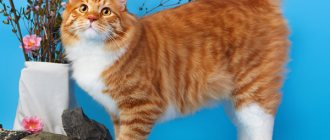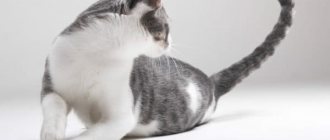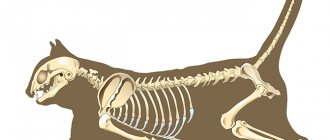There is no bobtail cat breed as such. This is a generic name for cats with short tails. This category includes the Kuril, Japanese, American and Mekong bobtails. There is also a Karelian variety, but scientists are still debating whether it should be classified as a separate breed. Funny bobtails with a mischievous character and exorbitant love for humans have gained popularity among cat lovers.
In this article we will tell you: what a bobtail is, why a bobtail has a short tail, how to care for them, what to feed them and how to raise them.
Types of bobtails and the history of their origin
Bobtail cats without a tail are a general name. In fact, there are several breeds: Japanese, Kuril, American, Mekong bobtails. Each breed originated at different times on different continents.
The Japanese Bobtail is an ancient native breed native to Asia. About 1000 years ago, short-tailed cats came to the Land of the Rising Sun from China. In Japan they are called Maneki Neko, which translates to “hello cat.” Cat figurines with raised paws are very popular here. Images of a greeting cat are found in temples and on store signs.
In 1968, American breeder Elizabeth Freret brought three Japanese Bobtail kittens to the United States. That same year, Lynn Beck brought out three males and five females and, with Freret's support, created the first breed standard, which was approved in 1971. In 1990, the breed was recognized by FIFe and other felinological associations with the exception of GCCF.
Japanese Bobtails are large, somewhat obese animals with thick hair. There are two varieties: short-haired and long-haired. The most popular colors are tricolor or harlequin and bicolor.
Japanese Bobtail
The Kurilian Bobtail is a direct relative of the Japanese Bobtail and the Siberian cat. Experts admit that the first cats came to the Kuril Islands along with sailors and firmly settled on the islands. Over several hundred years, animals gradually became unaccustomed to people and adapted to harsh living conditions. The changeable Far Eastern climate has rewarded cats with a lush and warm fur coat, sharp eyesight, powerful paws with sharp claws that do not hide in the pads.
A distinctive breed feature is a small pom-pom tail. In their homeland, “Kurilians” live in packs, hunting small game and fish together. They are unsurpassed hunters with lightning-fast reactions. Natural agility allows them to conquer any heights, and their sharp mind allows them to instantly adapt to any situation.
The Karelian Bobtail was first discovered in Karelia in the 90s. XX century Before this, the animals lived quietly on Lake Ladoga. Some felinologists believe that the Norwegian forest cat took part in the formation of the breed, others are sure that the breed originated from ordinary cats whose owners cut off their tails, fearing that the murka on the tail might bring a snake into the house. The second version, of course, is more like a legend, because the short tail is a genetic mutation.
The pedigree of the “Karelians” causes debate among felinologists. One of the reasons is the small number of short-tailed cats outside their homeland. All the cats that felinologists study were brought from Karelia. In 1990, the first breed standard was developed, and in 1994 the breed was recognized by the WCF. The breed is still considered small even in its homeland, where the animals live in prides. When kept at home, cats rarely mark their territory. “Girls” show attention to “boys” only once every six months.
The American Bobtail appeared in the 60s. XX century. The Sanders couple were vacationing in Southern Arizona and picked up a tabby kitten with a short tail and named him Yodi. The baby went with his owners to Iowa, where a fateful meeting with the Siamese Misha awaited him. The fruits of their love had all the characteristics of the modern American Bobtail breed.
The story didn't end there. Mindy Schultz and Charlotte Bentley bought kittens and enthusiastically began breeding the breed. A standard was introduced in 1970, and the breed was recognized by TICA in 1989. There are two varieties of the breed: long-haired and short-haired.
The Mekong Bobtail is named after the Mekong River. Initially, the cats were called Siamese, later Thai, and in 2003 the official name Mekong Bobtail was assigned to the breed. Representatives of the breed came to Europe in the 80s, and in the 90s. XIX century - in the USA. The Mekong Bobtail remained in the shadows for a long time and was considered a type of Siamese cat, so breeders culled animals with short tails.
Later, felinologists noticed that there were differences in the physique and position of the ears. Russian breeders began breeding the breed seriously in the 20th century. The first standard was presented in 1994, and in 1998 experts made additions. In 2004, the breed received MVT indexation.
Kurilian Bobtail
Introduction
Cats are amazing and mysterious creatures, once deified by the inhabitants of Ancient Egypt. For many centuries, the presence of a cat at a person’s hearth gave his home a special coziness and contributed to the emergence of emotional comfort.
Siamese cats are perhaps the most interesting among the representatives of the cat tribe. They have a sense of self-esteem that is rare for many animals. They will never allow themselves to be intrusive and at the same time they are ready to rush to protect human interests at the first call. Despite their fairly independent nature, they are good companions for children and the elderly. But you shouldn’t get a cat just to have it become a small child’s toy. Excessive activity and cruelty of a child, often unconscious, can lead to tragedy. Keeping Siamese cats involves some material and emotional costs, which will fully justify themselves over time, since you will have a graceful and well-mannered creature next to you.
Therefore, if the listed difficulties do not scare you, you can take the first step and bring home a small, cheerful kitten.
Description and breed standard
Bobtail varieties have both common and distinctive features. For clarity, we have prepared a table for you.
| Kuril | Karelian | Japanese | American | Mekong | |
| Head | Triangular, in males trapezoidal due to massive whisker pads | Wedge-shaped. | Equilateral triangle. | Wedge-shaped. | Round, high cheekbones. |
| Eye shape | Eastern, slanting | Oval. | Oval. | Almond-shaped. | Oval. |
| Iris | Yellow, green. White cats have blue. | Green. | Green, amber. | Green, amber. | Blue. |
| Ears | Triangular with rounded tips and tassels. | Triangular with rounded tips. | Large, erect, pubescent from the inside, rounded tips are decorated with tassels. | Triangular, large. | Large, triangular, with tassels. |
| Frame | Squat. | Slender, graceful | Elongated, massive. | Squat, massive. | Rectangular, graceful. |
| Tail | "Pompon". For short-haired dogs - 3-8 cm, for long-haired ones - up to 13 cm. | “Pom-pom” 4-13 cm long. | "Pom-pom" up to 7.5 cm. | Short and slightly widened at the base, up to 7 cm long. | Consists of 3 vertebrae, has a characteristic fracture. |
| Limbs | The hind ones are longer than the front ones. | The hind ones are longer than the front ones. | The hind limbs are longer than the forelimbs. | The hind ones are longer than the front ones. | The hind ones are longer than the front ones. |
| Paws | Rounded, fingers curled. The claws do not retract. | Round, graceful, hidden claws. | Oval, claws retracted. | Large, rounded, claws retracted. | Oval, graceful, hidden claws. |
| Coat type | Thin, soft, almost without undercoat. | Soft, silky, almost without undercoat. | Smooth, almost no undercoat. | Hard, dense with moderate undercoat. | Smooth, shiny. |
| Wool length | Short and long. There is a “collar” on the neck, and “pants” on the hind legs. | Short and semi-long. | Short. | Short and long. | Short. |
| Color | Smoky, two-, three-color, tabby. | Smoky, two-, three-color, tabby. | Any except chocolate, ticked tabby, color point, lilac. The tricolor is especially valued. | Tabby, light beige, dark red, brown, black, lilac, blue, cream. | Color point, red point, blue point and tabby point. |
| Weight | Males - 7.5 kg, females 4-5 kg. | Males - 5-6 kg, females - 3-4 kg. | Males - 5-7 kg, females - 4-5 kg. | Males - 5.5-9 kg, females - about 5 kg. | Males - 3.5-4 kg, females - 2.5-3 kg. |
Interesting. “Karelians” have an amazing voice, similar to the chirping of birds. Cats rarely meow literally; instead, they squeak quietly or simply nudge the owner with their paw.
American Bobtail
Types of tails
The tail of the Kurilian Bobtail, which resembles a rounded fluffy brush, deserves special attention. “Kurilians” are characterized by 4 types of tail:
- “Stump” - 8 deformed vertebrae.
- “Spiral” - 5-10 vertebrae.
- "Pastel" - 5-10 vertebrae.
- “Retracted bobtail” - 5-7 vertebrae.
Diagnostic methods
Tail diseases, in particular, fractures and other defects, are not affected and are determined only after the animal is delivered to the veterinary clinic. Veterinarians note that this should be done as soon as possible, especially with severe injuries. The scale is assessed using x-ray diagnostics. If a cat's tail is hanging because he broke it, and after that the animal's body is paralyzed, doctors recommend ultrasound and MRI, as well as electromyography - this is how the conductivity of nerve impulses is checked. If your cat does not lift his tail for neurological reasons, it may need to be cut off. Additionally, blood tests are prescribed before starting treatment.
Siamese cats and other breeds endure fractures painfully, but they allow the necessary research to be carried out. However, the presence of excited owners and changes in the environment can provoke panic in the animal. As a result, anesthesia will have to be used.
Character of bobtails
The Kurilian Bobtail is friends with all family members, but at the same time it singles out a favorite to whom it gives its heart. Cats protect their family like dogs, causing bewilderment to the enemy with loud meows. Representatives of the breed deliberately do not release their claws for self-defense if children unknowingly cause discomfort or pain during play.
The Kuril red bobtail combines absolutely opposite character traits - obedience and independence. Cats love human company, but they hate being held forcibly. If the owner does not pay attention to their needs, the pets begin to live by their own rules, gradually conquering the territory. Whenever an attempt is made to regain dominance, the cat begins to do mischief: he rides on the curtains, mocks the wallpaper and furniture, digs soil in the flower slides, chews on houseplants, urinates and slippers, etc.
American Bobtails are friendly, affectionate, gentle, balanced, loyal and sensitive, sensitive to the slightest changes in the owner’s mood. Scientists have proven that “American” dogs can have a beneficial effect on the human psyche and emotions and advise people suffering from depression to have a breed. Cats have an extraordinary mind, are not capricious, are easy to train, friendly, love to walk outside and quickly get used to a leash. “Americans” are able to bring objects and toys to their owner on command, which is reminiscent of dogs.
The Japanese Bobtail has a hot temperament and has earned a reputation for being unpredictable. This manifests itself most clearly at an early age: the thirst for impressions pushes fearless kittens to explore the world around them. The kids clearly don’t think about the consequences and leave behind a “pogrom.”
Representatives of the breed are not very friendly towards strangers, they are wary of them and prefer to observe their actions from a safe distance. The Japanese Bobtail loves its owner, but shows its feelings in a very original way. The playful “samurai” explores the contents of the owner’s closet, hoping to find something interesting there; he will come to have a heart-to-heart talk or lie next to him, but not for long.
There are no closed doors for the Japanese Black Bobtail. Doing revision is his favorite pastime. The cat simply does not react to angry shouts, and you will have to come to terms with this.
The Mekong Bobtail is a curious, cunning “bug” that loves to poke its snout into its owner’s affairs. This is a restless chatterbox, making funny cooing sounds, but at the same time he shows his feelings calmly. Representatives of the breed also know how to fetch objects on command. Cats use their teeth, but not their claws, to protect themselves. Thai Bobtails treat children calmly and are strongly attached to all family members.
Mekong Bobtail
Types of injury
When an animal receives an open injury, the problematic part of the body should be cropped.
There are 3 types of tail fractures in cats:
- Open. An open wound is visible, from which bones and tissues appear. At the same time, you can see how the tail hangs. This defect requires urgent treatment. Most likely you will need to dock your tail, unless it falls off on its own. Animals suffer greatly.
- Closed. The symptoms are similar to a bruise or dislocation, and the presence of a bend or break of an unnatural shape is visually noted. It may be noted that the base is swollen or an area that is damaged, and the tail itself has drooped. At the same time, the cat gets up and reacts to sounds and food.
- Broken. Often found in young cats. Such bruises do not lead to complete destruction of the vertebrae. If a cat has pain at the base of his tail, it seems that it is broken because it does not move. When there is a break at the tip, the organ moves, and only its strange shape arouses suspicion. If you bandage it tightly and do not touch it, the fracture will heal on its own.
Maintenance and care
The bobtail breed is unpretentious, so it is easy to care for cats. They hardly shed, they are clean, and the Kuril and Japanese love to swim. It is enough to brush the coat several times a week to maintain a neat appearance. To do this, you can use a metal comb, a furminator or a silicone glove.
American bobtails do not tolerate bathing procedures, but this is not scary; owners can easily do without bathing if the cat does not go outside. If the pet has access to free range, once every 3-4 months it will still have to be washed in warm water with the addition of a mild shampoo.
The eyes are washed with clean water or a special liquid 1-2 times a week. Wipe the ears with a damp cloth or clean cloth moistened with water or lotion.
Teeth are brushed once a week with a special finger attachment or a children’s toothbrush. The claws are trimmed with a nail clipper as they grow. Smokers wear their claws down on their own, especially if they walk outside.
Japanese Bobtails have almost no downy layer, which has led to increased sensitivity to drafts and cold. At home, it is better to place the bed in a warm place, but away from radiators. Japanese wool has a water-repellent effect and does not lather well. This must be taken into account when applying shampoo. You may want to skip washing and use wet wipes to remove dust. This also applies to the Mekong Bobtail.
Bobtail nutrition
The most preferred type of food for bobtails is natural. Animals are given fresh foods: meat (except pork and lamb), fish (except bony river fish), offal (except liver), greens, sweet potatoes, carrots, zucchini, pumpkin, broccoli and cauliflower, apples, pears, berries, rice, oats and buckwheat.
You cannot feed cats from the table with salty, sweet and seasoned food that is familiar to humans. For meat, it is preferable to give rabbit, chicken, turkey, veal, and beef. Twice a week, give your pet cottage cheese, yogurt, sour cream, yogurt, and quail eggs.
American Bobtails are prone to obesity, so it is important to feed them at the same time. We advise you to get an automatic feeder with a timer, which will dispense a portion of food at a strictly allotted time.
Health and how long they live
Bobtails have good health and rarely get sick. Proper care, routine veterinary examinations, and timely vaccinations help preserve the health of cats. The list of mandatory vaccinations looks like this:
- calicivirus;
- panleukopenia;
- rhinotracheitis;
- leptospirosis;
- rabies.
The first vaccination is given at 3 months, a month later a revaccination is performed with the addition of protection against rabies. Then cats are vaccinated every year. Treatment for helminths is carried out within 10 days.
Smokers sometimes experience rectal prolapse, worsening hemorrhoids, and cracks and inflammation in the anus area.
Their life expectancy is 15-18 years.
American bobtails live 15-20 years and do not have severe intrabreed diseases. Some individuals are diagnosed with urolithiasis, diabetes mellitus, gingivitis, gastrointestinal dysfunction, volvulus and periodontal disease.
Japanese bobtails 14-16 years old are a native breed that at one time did a great job of preserving the genotype. They are not diagnosed with hereditary diseases. With proper care and timely visit to the veterinarian, cats live long and happy lives.
Mekong Bobtails are real long-livers. Their average life expectancy is 20 years, the maximum is 22 years. Animals are not prone to hereditary diseases, but sometimes they are diagnosed with rhinotracheitis, gingivitis, renal failure and arthritis.
Kurilian Bobtail
Breeding
Bobtail breeding is strictly controlled by the international felinological organization. Mating with other breeds is strictly prohibited and requires compliance with certain rules:
- The male and female must be one year old. Kurilian bobtails are bred after 2 years. at the age of 1 year, females mature a month later. Experienced breeders untie cats by the age of 2, when the reproductive system is fully formed.
- For mating, contact the breed club, where specialists check the veterinary passport, pedigree, diplomas and health status of the animal.
- Only healthy individuals with the same length of fur and tail are allowed for crossing. An additional condition is blood group compatibility.
- The female remains in the male's territory for 2-3 days.
How to choose a kitten
Bobtail cats are considered rare and exotic. Therefore, it is better to purchase a kitten in nurseries or from breeders with a good reputation. General rules for choosing a kitten for all breeds and bobtails, in particular:
- The kitten should be active and playful, not afraid to approach people;
- Eyes and ears should be clean, the skin should be free of wounds and ulcers;
- The mouth should be clean and pink;
- The tummy should not be bloated;
- The fur under the tail should be clean, there should be no cracks or redness on the anus;
- If it is not possible to see the kitten in person, then you need to request a photo of him and his parents;
- A veterinary passport and pedigree are required;
- The optimal age for changing homes is 3 months.
A short tail is a distinctive feature of a true bobtail. The presence of creases and hooks depends on the breed.
Bobtails are becoming increasingly popular among breeders
Bobtails are not suitable for a person who prefers a calm animal, as they are very active and playful. But in all other respects, this is an ideal pet. He is cheerful, obedient, and does not require special care. The bobtail breed is relatively young, so these cats are not very common. But their popularity is growing year by year and, fortunately, each animal finds a loving owner.
Kitten in the house
From the first days of bobtail kittens appearing in the house, the owner must provide ideal conditions for their maintenance.
Care and feeding
Kitten feeding regimen:
- up to 4 months - up to 6 times;
- 4-9 months - 4 times;
- after 10 months - 2-3 times.
You need to feed with natural products: lean frozen meat, boiled boneless fish, squid, quail eggs or chicken egg yolk, sour cream, yogurt, cottage cheese, yogurt, raw cow tripe. Protein products can be mixed with buckwheat, rice, oatmeal, fresh or lightly steamed vegetables.
When it comes to dry food, choose products marked premium and super premium, or even better, holistic. Canned food should not make up more than 25% of the main diet. You cannot combine natural products and industrial feed.
As the bobtail cat grows, it will begin to change its coat. Sometimes vomiting with fur is possible, which the baby licks off himself. Buy a special hair removal paste to help your kitten.
Weight by month
The table shows the weight of bobtail kittens from 3 to 12 months.
| Age, months | Male, kg | Female, kg |
| 3 | 1,8 | 1,5 |
| 4 | 2,5 | 1,8 |
| 5 | 2,9 | 2,3 |
| 6 | 3,4 | 2,56 |
| 7 | 3,75 | 2,64 |
| 8 | 4 | 2,7 |
| 9 | 4,15 | 2,8 |
| 10 | 4,3 | 2,87 |
| 11 | 4,35 | 3 |
| 12 | 4,5 | 3,4 |
Popular nicknames
We have collected popular bobtail nicknames for you.
| "Girls" | "Boys" |
| Diana | Bernie |
| Alicia | Vulture |
| Grace | Daniel |
| Pearl | Jacques |
| Olivia | Georges |
| Marianne | Korzhik |
| Button | Mario |
| Isabelle | Matisse |
| Nara | Nils |
| Jacqueline | Theodore |
How much does a bobtail cat cost?
For clarity, we have created a table of pricing policies for different breeds of bobtails.
| Breed | Pat class, yew. rub. | Breed class, yew. rub. | Show class, yew. rub. |
| Kuril | 10 | 25 | 25 |
| American | 44 | 55 | 88 |
| Japanese | 35 | 40 | 65 |
| Mekong | 35 | 47 | 60 |
Reference. American Bobtails are bred in the USA. The breed is rare in the Russian Federation and CIS countries.
Animals with obvious deviations from the breed standard can be purchased at a symbolic price.
Color
Until 2005, only 3 colors were officially recognized:
- Seal point or classic Siamese color. The coat has a creamy to light brown tint. Darker spots (even black-brown) on the face, paws, ears and tail.
- Red point is the rarest. The coat has a peach tint, and the characteristic spots have a reddish tint.
- Tortie point is a tortoiseshell color.
Torty Point
In subsequent years, the popularity of the breed increased and, thanks to selection, several more colors appeared:
- blue point – the fur on the body has a silvery tint, and the points on the face, tail and paws are bluish-pink;
- chocolate point – white body, and chocolate-colored spots;
- tabby – the dark letter “m” is clearly visible on the forehead, and the spots are striped.
Tabby color
Nurseries who are keen on breeding are now breeding cats with lilac and golden fur.
Advantages and disadvantages of bobtails
Advantages of bobtails:
- attractive exterior;
- playfulness;
- lack of aggression;
- balanced character;
- high intelligence;
- no problems with upbringing;
- cleanliness;
- pickiness in food and care.
Flaws:
- tendency towards obesity among “Americans”;
- desire to take a dominant position (Japanese);
- unfriendly attitude towards strangers (Japanese);
- hyper-reactivity;
- early sexual maturity in the Mekong.











